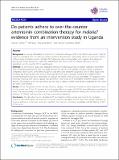| dc.contributor.author | Cohen, Jessica L. | |
| dc.contributor.author | Yavuz, Elif Nazmiye | |
| dc.contributor.author | Morris, Alexandra | |
| dc.contributor.author | Arkedis, Jean | |
| dc.contributor.author | Sabot, Oliver | |
| dc.date.accessioned | 2013-04-01T19:03:42Z | |
| dc.date.issued | 2012 | |
| dc.identifier.citation | Cohen, Jessica L, Elif Yavuz, Alexandra Morris, Jean Arkedis, and Oliver Sabot. 2012. Do patients adhere to over-the-counter artemisinin combination therapy for malaria? Evidence from an intervention study in Uganda. Malaria Journal 11:83. | en_US |
| dc.identifier.issn | 1475-2875 | en_US |
| dc.identifier.uri | http://nrs.harvard.edu/urn-3:HUL.InstRepos:10483976 | |
| dc.description.abstract | Background: Increasing affordability of artemisinin combination therapy (ACT) in the African retail sector could be critical to expanding access to effective malaria treatment, but must be balanced by efforts to protect the efficacy of these drugs. Previous research estimates ACT adherence rates among public sector patients, but adherence among retail sector purchasers could differ substantially. This study aimed to estimate adherence rates to subsidized, over-the-counter ACT in rural Uganda. Methods: An intervention study was conducted with four licensed drug shops in Eastern Uganda in December 2009. Artemether-lumefantrine (AL) was made available for sale at a 95% subsidy over-the counter. Customers completed a brief survey at the time of purchase and then were randomly assigned to one of three study arms: no follow-up, follow-up after two days or follow-up after three days. Surveyors recorded the number of pills remaining through blister pack observation or through self-report if the pack was unavailable. The purpose of the three-day follow-up arm was to capture non-adherence in the sense of an incomplete treatment course ("under-dosing"). The purpose of the two-day follow-up arm was to capture whether participants completed the full course too soon ("over-dosing"). Results: Of the 106 patients in the two-day follow-up sample, 14 (13.2%) had finished the entire treatment course by the second day. Of the 152 patients in the three-day follow-up sample, 49 (32.2%) were definitely non-adherent, three (2%) were probably non-adherent and 100 (65.8%) were probably adherent. Among the 52 who were non-adherent, 31 (59.6%) had more than a full day of treatment remaining. Conclusions: Overall, adherence to subsidized ACT purchased over-the-counter was found to be moderate. Further, a non-trivial fraction of those who complete treatment are taking the full course too quickly. Strategies to increase adherence in the retail sector are needed in the context of increasing availability and affordability of ACT in this sector. | en_US |
| dc.language.iso | en_US | en_US |
| dc.publisher | BioMed Central | en_US |
| dc.relation.isversionof | doi:10.1186/1475-2875-11-83 | en_US |
| dc.relation.hasversion | http://www.ncbi.nlm.nih.gov/pmc/articles/PMC3342228/pdf/ | en_US |
| dash.license | LAA | |
| dc.title | Do patients adhere to over-the-counter artemisinin combination therapy for malaria? Evidence from an intervention study in Uganda | en_US |
| dc.type | Journal Article | en_US |
| dc.description.version | Version of Record | en_US |
| dc.relation.journal | Malaria Journal | en_US |
| dash.depositing.author | Cohen, Jessica L. | |
| dc.date.available | 2013-04-01T19:03:42Z | |
| dc.identifier.doi | 10.1186/1475-2875-11-83 | * |
| dash.contributor.affiliated | Yavuz, Elif Nazmiye | |
| dash.contributor.affiliated | Cohen, Jessica | |


